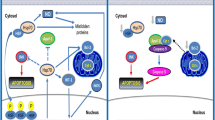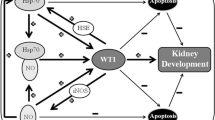Abstract
Background
Mechanical stress is a key pathogenic driver of apoptosis in the tubular epithelium in obstructive nephropathy. Heat shock protein 70 (Hsp70) and Wilms’ tumor (WT-1) have been proposed to represent linked downstream effectors of the cytoprotective properties of NO. In the present study, we sought to evaluate whether the cytoprotective effects of l-arginine in neonatal obstructive nephropathy may be associated with NO-dependent increases in WT-1 and Hsp70 expression.
Methods
Neonatal Wistar–Kyoto rats were submitted to complete unilateral ureteral obstruction (UUO) and treated thereafter with vehicle, L-NAME or l-arginine by daily gavage for 14 days to block or augment NO levels, respectively. Normal rat kidney epithelial cells by NRK-52E were exposed to mechanical stress in vitro in the presence or absence of L-NAME, l-arginine, sodium nitroprusside (SNP), l-arginine + SNP or l-arginine/L-NAME. Induction of apoptosis and the mRNA expression of WT-1 and Hsp70 genes were assessed.
Results
WT-1 and Hsp70 genes expression decreased in the presence of L-NAME and following UUO coincident with increased tubular apoptosis. l-arginine treatment increased NO levels, reduced apoptosis and restored expression levels of WT-1 and Hsp70 to control levels. l-arginine treatment in vitro reduced basal apoptotic rates and prevented apoptosis in response to mechanical strain, an effect enhanced by SNP co-incubation. L-NAME increased apoptosis and prevented the anti-apoptotic action of l-arginine.
Conclusions
l-arginine treatment in experimental neonatal UUO reduces apoptosis coincident with restoration of WT-1 and Hsp70 expression levels and directly inhibits mechanical strain-induced apoptosis in an NO-dependent manner in vitro. This potentially implicates an NO-Hsp70-WT-1 axis in the cytoprotective effects of l-arginine.











Similar content being viewed by others
References
Chevalier RL (2004) Obstructive nephropathy and the developing kidney: too little or too much angiotensin? Kidney Int 65:1517–1518
Docherty NG, O’Sullivan OE, Healy DA, Fitzpatrick JM, Watson RW (2006) Evidence that inhibition of tubular cell apoptosis protects against renal damage and development of fibrosis following ureteric obstruction. Am J Physiol Ren Physiol 290:F4–F13
Power RE, Doyle BT, Higgins D, Brady HR, Fitzpatrick JM, Watson RW (2004) Mechanical deformation induced apoptosis in human proximal renal tubular epithelial cells is caspase dependent. J Urol 171:457–461
Manucha W (2007) Biochemical-molecular markers in unilateral ureteral obstruction. Biocell 31:1–12
Dendooven A, Ishola DA, Nguyen TQ, Van der Giezen DM, Kok RJ, Goldschmeding R, Joles JA (2011) Oxidative stress in obstructive nephropathy. Int J Exp Pathol 92:202–210
Manucha W, Carrizo L, Ruete C, Molina H, Vallés P (2005) Angiotensin II type I antagonist on oxidative stress and heat shock protein 70 (HSP-70) expression in obstructive nephropathy. Cell Mol Biol (Noisy-le-grand) 51(6):547–555
Mazzei LJ, Garcia IM, Altamirano L, Docherty N, Manucha W (2012) Rosuvastatin preserves renal structure following unilateral ureteric obstruction in the neonatal rat. Am J Nephrol 35(2):103–113
Manucha W, Vallés P (2008) Hsp70/nitric oxide relationship in apoptotic modulation during obstructive nephropathy. Cell Stress Chaperones 13(4):413–420
Manucha W, Vallés P (2008) Cytoprotective role of nitric oxide associated with Hsp70 expression in neonatal obstructive nephropathy. Nitric Oxide 18:204–215
Messmer UK, Brune B (1996) Nitric oxide-induced apoptosis: p53-dependent and p53-independent signaling pathways. Biochem J 319:299–305
Kim YM, de Vera ME, Watkins SC, Billiar TR (1997) Nitric oxide protects cultured rat hepatocytes from tumor necrosis factor-alphainduced apoptosis by inducing heat shock protein 70 expression. J Biol Chem 272:1402–1411
Mannick JB, Miao XQ, Stamler JS (1997) Nitric oxide inhibits Fas induced apoptosis. J Biol Chem 272:24125–24128
Xu Q, Hu Y, Kleindienst R, Wick G (1997) Nitric oxide induces heat-shock protein 70 expression in vascular smooth muscle cells via activation of heat shock factor 1. J Clin Invest 100:1089–1097
Uchiyama T, Atsuta H, Utsugi T, Oguri M, Hasegawa A, Nakamura T, Nakai A, Nakata M, Maruyama I, Tomura H, Okajima F, Tomono S, Kawazu S, Nagai R, Kurabayashi M (2007) HSF1 and constitutively active HSF1 improve vascular endothelial function (heat shock proteins improve vascular endothelial function. Atherosclerosis 190:321–329
Bhagat K, Vallance P (1996) Nitric oxide 9 years on. J R Soc Med 89:667–673
Moncada S (1997) Nitric oxide in the vasculature: physiology and pathophysiology. Ann N Y Acad Sci 811:60–67
Hegarty NJ, Young LS, Kirwan CN, O’Neill AJ, Bouchier-Hayes DM, Sweeney P, Watson RW, Fitzpatrick JM (2001) Nitric oxide in unilateral ureteral obstruction: effect on regional renal blood flow. Kidney Int 59:1059–1065
Ito K, Chen J, Seshan SV, Khodadadian JJ, Gallagher R, El Chaar M, Vaughan ED Jr, Poppas DP, Felsen D (2005) Dietary arginine supplementation attenuates renal damage after relief of unilateral ureteral obstruction in rats. Kidney Int 68:515–528
Yoo KH, Thornhill BA, Forbes MS, Chevalier RL (2010) Inducible nitric oxide synthase modulates hydronephrosis following partial or complete unilateral ureteral obstruction in the neonatal mouse. Am J Physiol Renal Physiol 298:F62–F71
Forbes MS, Thornhill BA, Park MH, Chevalier RL (2007) Lack of endothelial nitric-oxide synthase leads to progressive focal renal injury. Am J Pathol 170(1):87–99
Hochberg D, Johnson CW, Chen J, Cohen D, Stern J, Vaughan ED Jr, Poppas D, Felsen D (2000) Interstitial fibrosis of unilateral ureteral obstruction is exacerbated in kidneys of mice lacking the gene for inducible nitric oxide synthase. Lab Invest 80:1721–1728
Tirani SA, Pezeshki Z, Nematbakhsh M, Nasri H, Talebi A (2015) Effect of l-arginine and L-NAME on kidney tissue damage in rats after 24 h of bilateral ureteral obstruction. Int J Prev Med 6:60
Mazzei L, García IM, Cacciamani V, Benardón ME, Manucha W (2010) WT-1 mRNA expression is modulated by nitric oxide availability and Hsp70 interaction after neonatal unilateral ureteral obstruction. Biocell 34(3):121–132
Manucha W, Kurbán F, Mazzei L, Benardón ME, Bocanegra V, Tosi MR, Vallés P (2011) eNOS/Hsp70 interaction on rosuvastatin cytoprotective effect in neonatal obstructive nephropathy. Eur J Pharmacol 650(2–3):487–495
Zhou MS, Schuman IH, Jaimes EA, Raij L (2008) Renoprotection by statins is linked to a decrease in renal oxidative stress, TGFbeta, and fibronectin with concomitant increase in nitric oxide bioavailability. Am J Physiol Renal Physiol 295:F53–F59
García IM, Mazzei L, Benardón ME, Oliveros L, Cuello-Carrión FD, Gil Lorenzo A, Manucha W, Vallés P (2012) Caveolin-1-eNOS/Hsp70 interactions mediate rosuvastatin antifibrotic effects in neonatal obstructive nephropathy. Nitric Oxide 27(2):95–105
Mazzei L, Manucha W (2017) Growing evidence suggests WT1 effects in the kidney development are modulated by Hsp70/NO interaction. J Nephrol 30(1):11–18
Griess JO (1864) On a new series of in which nitrogen is substituted for hydrogen. Philos Trans R Soc Lond B Biol Sci 154:667–731
Morrissey J, Hruska K, Guo G, Wang S, Chen Q, Klahr S (2002) Bone morphometric protein-7 improves renal fibrosis and accelerates the return of renal function. J Am Soc Nephrol 13:S14–S21
Ciocca DR, Cuello-Carrión FD, Natoli AL, Restall C, Anderson RL (2012) Absence of caveolin-1 alters heat shock protein expression in spontaneous mammary tumors driven by Her-2/neu expression. Histochem Cell Biol 137(2):187–194
Liapis H (2003) Biology of congenital obstructive nephropathy. Nephron Exp Nephrol 93:87–91
Goloubinoff P, De Los Rios P (2007) The mechanism of Hsp70 chaperones: (entropic) pulling the models together. Trends Biochem Sci 32:372–380
Cheng H, Cenciarelli C, Shao Z, Vidal M, Parks WP, Pagano M, Cheng-Mayer C (2001) Human T cell leucemia virus type 1 Tax associates with a molecular chaperone complex containing hTid-1 and Hsp70. Curr Biol 11:1771–1775
Jäättelä M (1999) Escaping cell death: survival proteins in cancer. Exp Cell Res 248:30–43
Li F, Mao HP, Ruchalski KL, Wang YH, Choy W, Schwartz JH, Borkan SC (2002) Heat stress prevents mitochondrial injury in ATP-depleted renal epithelial cells. Am J Physiol Cell Physiol 283:917–926
Maheswaran S, Englert C, Zheng G, Lee SB, Wong J, Harkin DP, Bean J, Ezzell R, Garvin AJ, McCluskey RT, DeCaprio JA, Haber DA (1998) Inhibition of cellular proliferation by the Wilms tumor suppressor WT-1 requires association with the inducible chaperone Hsp70. Genes Dev 12:1108–1120
Hegarty NJ, Watson RW, Young LS, O’Neill AJ, Brady HR, Fitzpatrick JM (2002) Cytoprotective effects of nitrates in a cellular model of hydronephrosis. Kidney Int 62:70–77
Mazzei L, Docherty NG, Manucha W (2015) Mediators and mechanisms of heat shock protein 70 based cytoprotection in obstructive nephropathy. Cell Stress Chaperones 20(6):893–906
Murphy ME (2013) The Hsp70 family and cancer. Carcinogenesis 34(6):1181–1188
Saylam K, Simon P (2003) WT1 gene mutation responsible for male sex reversal and renal failure: the Frasier syndrome. Eur J Obstet Gynecol Reprod Biol 110(1):111–113
Hohenstein P, Hastie ND (2006) The many facets of the Wilms’ tumour gene, WT1. Hum Mol Genet 15(Spec No 2):R196–R201
Barisoni L, Kriz W, Mundel P, D’Agati V (1999) The dysregulated podocyte phenotype: a novel concept in the pathogenesis of collapsing idiopathic focal segmental glomerulosclerosis and HIV-associated nephropathy. J Am Soc Nephrol 10(1):51–61
Moore AW, McInnes L, Kreidberg J, Hastie ND, Schedl A (1999) YAC complementation shows a requirement for Wt1 in the development of epicardium, adrenal gland and throughout nephrogenesis. Development 126(9):1845–1857
Huang B, Pi L, Chen C, Yuan F, Zhou Q, Teng J, Jiang T (2012) WT1 and Pax2 re-expression is required for epithelial-mesenchymal transition in 5/6 nephrectomized rats and cultured kidney tubular epithelial cells. Cells Tissues Organs 195(4):296–312
Funding
This work was supported by Grants from the Research and Technology Council of Cuyo University (SECyT), Mendoza, Argentina, and PICT 2012-0234.
Author information
Authors and Affiliations
Corresponding author
Ethics declarations
Conflict of interest
The authors have declared that no conflict of interest exists (financial or non-financial).
Ethical statement
All procedures performed in studies involving animals were in accordance with the ethical standards of the institution or practice at which the studies were conducted (IRB approval number 48/2015). This article does not contain any studies with human participants performed by any of the authors.
Rights and permissions
About this article
Cite this article
Mazzei, L., Cuello-Carrión, F.D., Docherty, N. et al. Heat shock protein 70/nitric oxide effect on stretched tubular epithelial cells linked to WT-1 cytoprotection during neonatal obstructive nephropathy. Int Urol Nephrol 49, 1875–1892 (2017). https://doi.org/10.1007/s11255-017-1658-z
Received:
Accepted:
Published:
Issue Date:
DOI: https://doi.org/10.1007/s11255-017-1658-z




